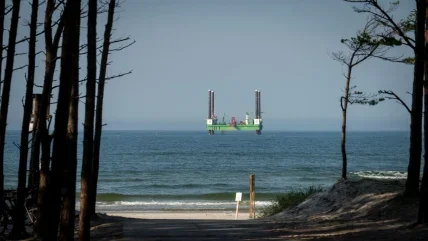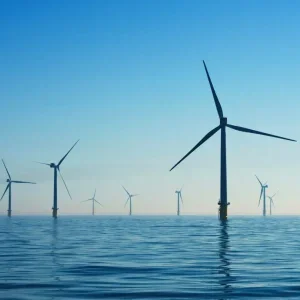
Orlen has announced that the Baltic Power offshore wind farm has reached a key milestone, completing the first of four directional drills under the coastline, beach, and seabed in the Lubiatowo area. This critical phase allows the connection of the wind farm to its onshore substation, all while ensuring there is no direct impact on ecologically sensitive areas.
The newly constructed 1.4 km tunnel will accommodate power transmission cables, with the drilling process conducted using HDD (horizontal directional drilling) technology.
This achievement marks a significant step for the project, as it is the first large-scale use of HDD technology in Poland.
The completed section is one of four underground corridors, each designed to hold 30-cm diameter cables. Part of the operation was performed offshore, employing divers and a jack-up rig to complete the underwater section. In total, over 8,000 cubic metres of spoil will be extracted from the four drills.
Baltic Power Management Board member Jarosław Broda said: “Progress on Baltic Power, the largest renewable energy project in our region, is on schedule and already well advanced.
“We have completed the first and are carrying out further drilling for submarine cables connecting offshore substations to land. This is the first project of its kind in Poland and is unique compared to other offshore wind projects carried out in Europe.”
Studies commissioned by Baltic Power have shown that the excavated sand is clean and suitable for use in beach restoration projects, which will help repair damage caused by winter storms.
This development represents a significant step forward for Poland’s wind energy sector and the larger European green energy landscape. The project highlights innovative approaches in offshore wind farm construction while minimising environmental impact.
The Baltic Power wind farm project is being carried out with the goal of minimising disruption to local residents, tourists, and the environment. To reduce inconvenience, heavy equipment is transported to the drilling site mainly during the night, with vehicles travelling at a controlled speed of 10 km/h, escorted to ensure safety.
After consultations with local authorities, the community, and tourism industry representatives, it was agreed that the popular beach access path near the worksite would remain open, ensuring uninterrupted access for tourists and cyclists.
Meanwhile, construction of the onshore substation is progressing approximately 8 km away in Osieki Lęborskie. Together with the cable connection, the substation will receive energy from the Baltic Power wind farm and integrate it into the National Power Grid. The power line connecting to the substation will also be installed underground.
The route for the onshore cable has been planned in coordination with other offshore wind farm developers to minimise environmental impact and avoid areas of ecological importance. The onshore substation’s construction is now more than 40% complete, with full completion targeted for the fourth quarter of 2025.
Baltic Power is among the first projects globally to install 15 MW wind turbines and the first to incorporate a significant portion of its turbine towers made from low-carbon steel.
Once operational in 2026, it will be the first Polish offshore wind farm in the Baltic Sea, covering approximately 3% of Poland’s energy demand and reducing CO2 emissions by an estimated 2.8 million tonnes annually.






